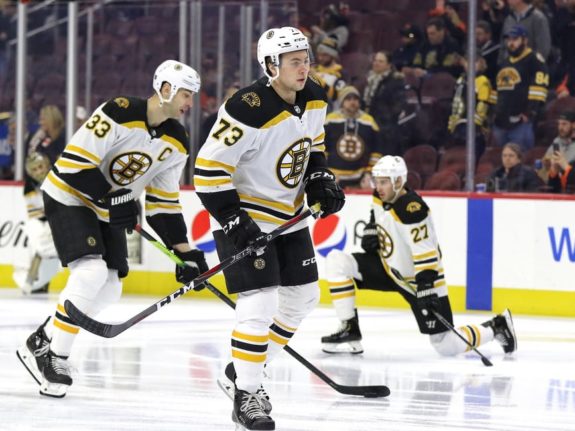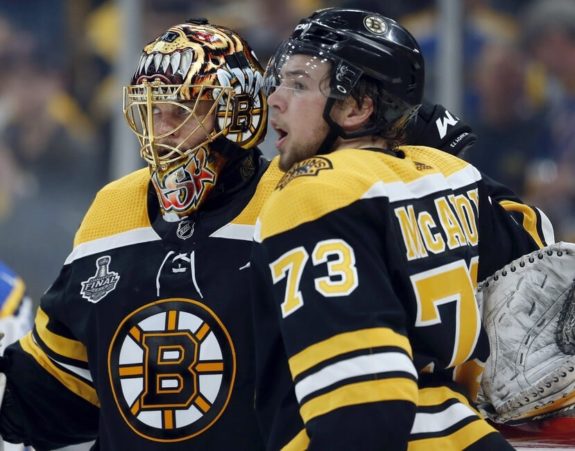When the latest CBA was agreed to, they forgot about the Charlie McAvoys of the world. The Boston Bruins have total control over McAvoy, and it’s probably the main reason he hasn’t been signed yet. He is ineligible for both arbitration and an offer-sheet due to his 10.2(c) restricted free agent status.
McAvoy signed his entry-level contract (ELC) at the end of the 2016-17 season and appeared in six playoff games for the Bruins. As soon as the ink hit the paper, the Bruins gained total control over him for the first two contracts of his career. The ELC was never going to slide because he played, but even if he hadn’t suited up for the Bruins in 2016-17 playoffs it still wouldn’t have been eligible to slide. The ELC slide is only valid for players 18 or 19 years of age, and who don’t turn 20 prior to Jan. 1 of their initial contract year.
As far as I understand, because of this, McAvoy’s first year of his contract (even though he played in the post-season) doesn’t count as a year of professional experience. It only counts as a burned year of his ELC. That leaves him with only the 2017-18 and 2018-19 seasons. To be eligible for arbitration and offer sheets you have to have three professional seasons if you signed the ELC between the ages of 18-21.

The Bruins currently have $7,294,167 in cap space. That would have been more than enough to lock up McAvoy for well into his prime years until Jacob Trouba signed his massive new contract with the New York Rangers. For all the things McAvoy’s representatives got wrong when he signed his initial contract, they are making up for it by holding out for as long as possible right now. While Mitch Marner and the Toronto Maple Leafs hold the spotlight, McAvoy waits in the shadows with only one card to play: sign nothing.
McAvoy Is the Future of the Bruins’ Blue Line
McAvoy spent around 60% of his 5-on-5 time with Zdeno Chara. That name still carries some weight, but it’s 2019, not 2009. McAvoy helped Chara look better than he actually was and likely got Chara some of that $2 million on his new deal. Chara dropped nearly a full percentage point in relative Corsi-For when he was away from McAvoy, regressing back to near even with 0.06. For the remaining 40% of McAvoy’s 5-on-5 time, he goes up by 0.27 relCF%.
Going back to Trouba, there’s a difference in how both players achieved success. McAvoy was the carrier on his most common pairing. Trouba would not get the same classification. His most frequent partner in Winnipeg during 2018-19 was Josh Morrisey (around 63.4% of his 5-on-5 time), but it was Morrisey that enjoyed more stable success with or without his partner. In the five seasons prior to 2018-19, Trouba exceeded 0.5 points-per-game only once. McAvoy did in both his first and second seasons. Here’s a quick look at their contribution at 5-on-5.
| Stat | McAvoy | Trouba |
| relCF60 | 5.03 | 4.51 |
| relCA60 | 0.68 | 0.72 |
| relCF% | 1.81 | 1.68 |
| P60 | 1.29 | 0.96 |
The argument isn’t whether or not both players deserve $8 million. That was settled by Jeff Gorton and the Rangers. The real argument now is how can the Bruins justify paying McAvoy less than Trouba when, under the surface, McAvoy is giving just as much or more to his team? The Bruins are essentially holding McAvoy hostage right now because of his rare restricted free agency status.

Trouba may have been given more defensive responsibilities throughout the year as far as usage goes, but McAvoy has proven he’s a valuable player. The point gap between the two players is significantly reduced when you just focus on 5-on-5 play. Here, Trouba only holds a 23-21 edge. An ideal outcome for McAvoy might be a two-year contract with less in average annual value (AAV) so he can set himself up for a potentially even bigger pay day. That’s not ideal for the team, though.
It’s hard to imagine the Bruins not including Charlie McAvoy in their long-term plans. He’s a good, young defenseman that should be a major part of their group moving forward. The Bruins currently only have three defenders (Connor Clifton, Steven Kamfer and John Moore) under contract on their active roster for 2020-21 after signing Clifton to an extension. That group just won’t cut it. McAvoy and Brando Carlo are currently awaiting new deals and Tory Krug’s contract ends at the conclusion of the 2019-20 league year.
The Bruins would be wise to get McAvoy on a longer-term contract now as opposed to a year, or two years, from now. Contract inflation is something that can hurt teams that choose bridge deals for players they know are effective. A two-year deal would also shorten the time that the Bruins have with full control over him as he would be considered a Group 2 restricted free agent.

The Bruins gain nothing by dragging this negotiation on. They have a good player who is entitled to a significant raise and who has already turned down offers with an AAV below his value. Their focus should be on finding his acceptable number and moving pieces around to accommodate the future of their blue line on a long-term basis.